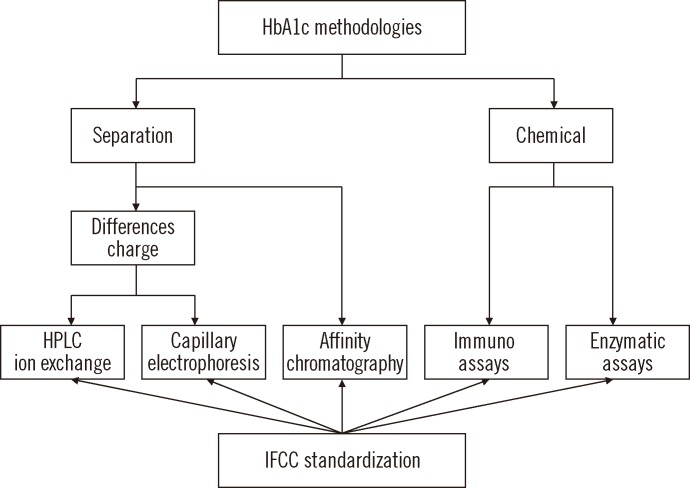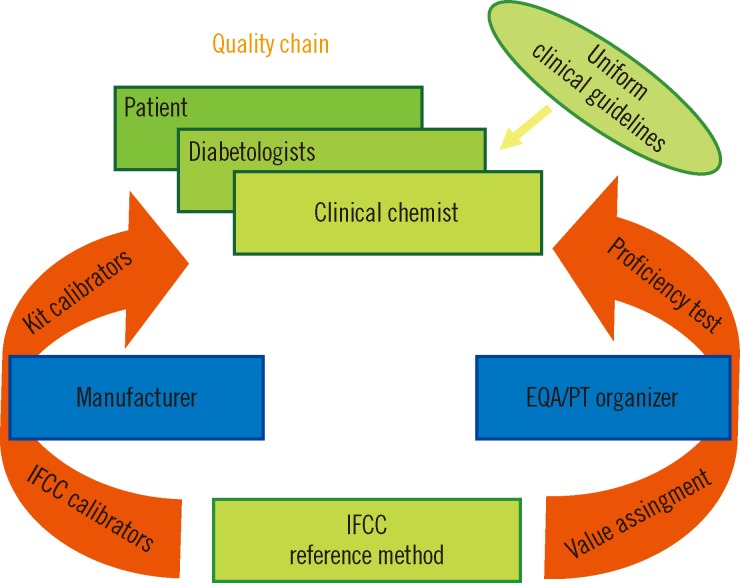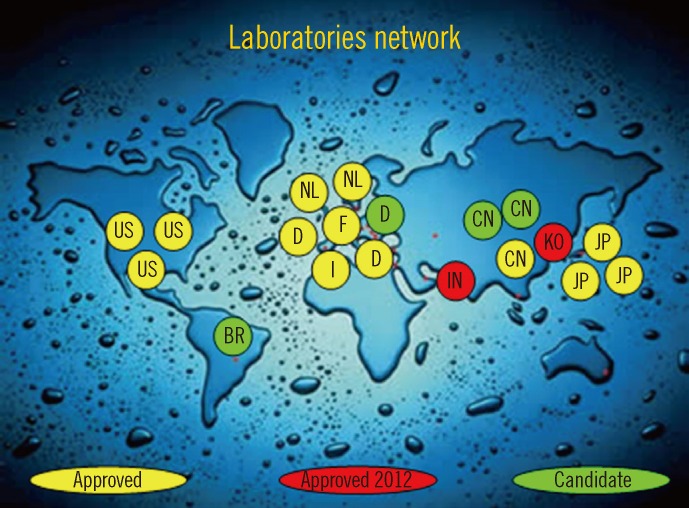Ann Lab Med.
2013 Nov;33(6):393-400. 10.3343/alm.2013.33.6.393.
HbA1c: A Review of Analytical and Clinical Aspects
- Affiliations
-
- 1MCA Laboratory, Queen Beatrix Hospital, Winterswijk, Netherlands. c.w.weykamp@skbwinterswijk.nl
- KMID: 1711310
- DOI: http://doi.org/10.3343/alm.2013.33.6.393
Abstract
- After the relationship between glycemic control and the HbA1c concentration was demonstrated, many tests have been developed to determine the HbA1c concentration. The test results are standardized to the International Federation of Clinical Chemistry (IFCC) Reference Measurement Procedure (RMP) in harmony with the efforts of the National Glycohemoglobin Standardization Program (NGSP). The longitudinal use of the test requires strict quality management including accreditation of the laboratory, a dedicated internal control design, participation in an external quality assessment (EQA) program (proficiency test), and careful consideration of pre- and post-analytical aspects of the test. Performance goals for optimizing determination of the HbA1c concentration have been described. As an index of long-term glycemic control and a risk predictor, the HbA1c concentration is an indispensable part of routine management of diabetes. Because of the improving quality of the test, the HbA1c concentration is being increasingly applied in the diagnosis of diabetes. There are, however, concerns of this application in point-of-care settings. The HbA1c concentration is also used to achieve stringent control in pregnant diabetic patients. Strict standardization enables the definition of universal reference values and clinical decision limits. This review describes the present status of analytical and clinical aspects of determining the HbA1c concentration and highlights the challenges involved.
Keyword
MeSH Terms
Figure
Cited by 3 articles
-
Exploration and Validation of the Performance of Hemoglobin A1c in Detecting Diabetes in Community-Dwellers With Hypertension
Shanhu Qiu, Ziwei Du, Wei Li, Juan Chen, Hang Wu, Jingbao Liu, Min Cai, Bei Wang, Haijian Guo, Zilin Sun
Ann Lab Med. 2020;40(6):457-465. doi: 10.3343/alm.2020.40.6.457.Evaluation of Cobas b 101 HbA1c Analyzer Performance for Point-of-Care Testing
Hui-Jin Yu, Sangeun Lim, Min-Jung Kwon, Hee-Yeon Woo, Hyosoon Park
Lab Med Online. 2017;7(4):182-188. doi: 10.3343/lmo.2017.7.4.182.Performance Evaluation of the i-SmartCare 10 Analyzer and Method Comparison of Six Point-of-Care Blood Gas Analyzers
Sang-Mi Kim, Hyung-Doo Park
Ann Lab Med. 2022;42(4):467-472. doi: 10.3343/alm.2022.42.4.467.
Reference
-
1. World Health Organization. WHO diabetes media centre. Updated on Mar 2013. http://www.who.int/mediacentre/factsheets/fs312/en/index.html.2. American Diabetes Association. Economic costs of diabetes in the U.S. In 2007. Diabetes Care. 2008; 31:596–615. PMID: 18308683.3. . The effect of intensive treatment of diabetes on the development and progression of long-term complications in insulin-dependent diabetes mellitus. The Diabetes Control and Complications Trial Research Group. N Engl J Med. 1993; 329:977–986. PMID: 8366922.4. . Intensive blood-glucose control with sulphonylureas or insulin compared with conventional treatment and risk of complications in patients with type 2 diabetes (UKPDS 33). UK Prospective Diabetes Study (UKPDS) Group. Lancet. 1998; 352:837–853. PMID: 9742976.5. White NH, Sun W, Cleary PA, Tamborlane WV, Danis RP, Hainsworth DP, et al. Effect of prior intensive therapy in type 1 diabetes on 10-year progression of retinopathy in the DCCT/EDIC: comparison of adults and adolescents. Diabetes. 2010; 59:1244–1253. PMID: 20150283.
Article6. Weykamp C, John WG, Mosca A. A review of the challenge in measuring hemoglobin A1c. J Diabetes Sci Technol. 2009; 3:439–445. PMID: 20144280.
Article7. Jeppsson JO, Kobold U, Barr J, Finke A, Hoelzel W, Hoshino T, et al. Approved IFCC reference method for the measurement of HbA1c in human blood. Clin Chem Lab Med. 2002; 40:78–89. PMID: 11916276.
Article8. Hoelzel W, Weykamp C, Jeppsson JO, Miedema K, Barr JR, Goodall I, et al. IFCC reference system for measurement of hemoglobin A1c in human blood and the national standardization schemes in the United States, Japan, and Sweden: a method-comparison study. Clin Chem. 2004; 50:166–174. PMID: 14709644.
Article9. Jaisson S, Leroy N, Meurice J, Guillard E, Gillery P. First evaluation of Capillarys 2 Flex Piercing (Sebia)® as a new analyzer for HbA1c assay by capillary electrophoresis. Clin Chem Lab Med. 2012; 50:1769–1775. PMID: 23089707.
Article10. Mallia AK, Hermanson GT, Krohn RI, Fujimoto EK, Smith PK. Preparation and use of a boronic acid support for separation and quantitation of glycosylated hemoglobins. Anal Lett. 1981; 14:649–661.11. John WG, Gray MR, Bates DL, Beacham JL. Enzyme immunoassay--a new technique for estimating haemoglobin A1c. Clin Chem. 1993; 39:663–666. PMID: 8472363.12. Liu L, Hood S, Wang Y, Bezverkov R, Dou C, Datta A, et al. Direct enzymatic assay for % HbA1c in human whole blood samples. Clin Biochem. 2008; 41:576–583. PMID: 18261468.13. Weykamp CW, Penders TJ, Muskiet FA, van der Slik W. Influence of hemoglobin variants and derivatives on glycohemoglobin determinations, as investigated by 102 laboratories using 16 methods. Clin Chem. 1993; 39:1717–1723. PMID: 7689046.
Article14. Little RR, Rohlfing CL. The long and winding road to optimal HbA1c measurement. Clin Chim Acta. 2013; 418:63–71. PMID: 23318564.
Article15. NGSP. HbA1c assay interferences. Updated on Jul 2013. http://www.ngsp.org/interf.asp.16. Greg Miller W, Myers GL, Lou Gantzer M, Kahn SE, Schönbrunner ER, Thienpont LM, et al. Roadmap for Harmonization of clinical laboratory measurement procedures. Clin Chem. 2011; 57:1108–1117. PMID: 21677092.
Article17. Little RR, Rohlfing CL, Wiedmeyer HM, Myers GL, Sacks DB, Goldstein DE. NGSP Steering Committee. The national glycohemoglobin standardization program: a five-year report. Clin Chem. 2001; 47:1985–1992. PMID: 11673367.18. Shima K, Endo J, Oimomi M, Omori Y, Katayama Y, Kanazawa Y, et al. Interlaboratory differences in GHb measurement in Japan: the fifth report of the GHb standardization committee, the Japan Diabetes Society. J Jap Diabetes Soc. 1998; 41:317–323.19. Jeppsson JO, Jerntorp P, Sundkvist G, Englund H, Nylund V. Measurement of hemoglobin A1c by a new liquid-chromatographic assay: methodology, clinical utility, and relation to glucose tolerance evaluated. Clin Chem. 1986; 32:1867–1872. PMID: 3757206.
Article20. Weykamp C, John WG, Mosca A, Hoshino T, Little R, Jeppsson JO, et al. The IFCC Reference Measurement System for HbA1c: a 6-year progress report. Clin Chem. 2008; 54:240–248. PMID: 18223132.
Article21. Sacks DB, Arnold M, Bakris GL, Bruns DE, Horvath AR, Kirkman MS, et al. Guidelines and recommendations for laboratory analysis in the diagnosis and management of diabetes mellitus. Clin Chem. 2011; 57:e1–e47. PMID: 21617152.
Article22. Consensus Committee. Consensus statement on the worldwide standardization of the hemoglobin A1C measurement: the American Diabetes Association, European Association for the Study of Diabetes, International Federation of Clinical Chemistry and Laboratory Medicine, and the International Diabetes Federation. Diabetes Care. 2007; 30:2399–2400. PMID: 17726190.23. Little RR, Rohlfing CL, Tennill AL, Connolly S, Hanson S. Effects of sample storage conditions on glycated hemoglobin measurement: evaluation of five different high performance liquid chromatography methods. Diabetes Technol Ther. 2007; 9:36–42. PMID: 17316096.
Article24. Little RR, Rohlfing CL, Sacks DB. Status of hemoglobin A1c measurement and goals for improvement: from chaos to order for improving diabetes care. Clin Chem. 2011; 57:205–214. PMID: 21148304.
Article25. Weykamp CW, Mosca A, Gillery P, Panteghini M. The analytical goals for hemoglobin A(1c) measurement in IFCC units and National Glycohemoglobin Standardization Program Units are different. Clin Chem. 2011; 57:1204–1206. PMID: 21571810.
Article26. American Diabetes Association. Standards of medical care in diabetes-2011. Diabetes Care. 2011; 34(S1):S11–S61. PMID: 21193625.27. American Diabetes Association. Standards of medical care in diabetes-2010. Diabetes Care. 2010; 33(S1):S11–S61. PMID: 20042772.28. John WG. UK Department of Health Advisory Committee on Diabetes. Use of HbA1c in the diagnosis of diabetes mellitus in the UK. The implementation of World Health Organization guidance 2011. Diabet Med. 2012; 29:1350–1357. PMID: 22957983.29. Seino Y, Nanjo K, Tajima N, Kadowaki T, Kashiwagi A, Araki E, et al. Report of the Committee on the Classification and Diagnostic Criteria of Diabetes Mellitus. J Diabetes Invest. 2010; 1:212–228.
Article30. WHO. Use of glycated haemoglobin (HbA1c) in the diagnosis of diabetes mellitus. http://www.who.int/diabetes/publications/report-hba1c_2011.pdf.31. Kitzmiller JL, Block JM, Brown FM, Catalano PM, Conway DL, Coustan DR, et al. Managing preexisting diabetes for pregnancy: summary of evidence and consensus recommendations for care. Diabetes Care. 2008; 31:1060–1079. PMID: 18445730.32. Davidson MB. Diabetes research and diabetes care. Where do we stand? Diabetes Care. 1998; 21:2152–2160. PMID: 9839110.
Article33. Larsen ML, Hørder M, Mogensen EF. Effect of long-term monitoring of glycosylated hemoglobin levels in insulin-dependent diabetes mellitus. N Engl J Med. 1990; 323:1021–1025. PMID: 2215560.
Article34. Ziemer DC, Kolm P, Weintraub WS, Vaccarino V, Rhee MK, Twombly JG, et al. Glucose-independent, black-white differences in hemoglobin A1c levels: a cross-sectional analysis of 2 studies. Ann Intern Med. 2010; 152:770–777. PMID: 20547905.35. Lenters-Westra E, Slingerland RJ. Six of eight haemoglobin A1c point-of-care instruments do not meet the general accepted analytical performance criteria. Clin Chem. 2010; 56:44–52. PMID: 19926777.
- Full Text Links
- Actions
-
Cited
- CITED
-
- Close
- Share
- Similar articles
-
- Evaluation of the Tosoh HLC-723 G7 Hemoglobin A1c Analyzer
- Analytical Performance of Bio-Rad D-100 on a Hemoglobin A1c Assay
- Evaluation of Cobas b 101 HbA1c Analyzer Performance for Point-of-Care Testing
- Paper-Based Analytical Device for Quantitative Urinalysis
- Evaluation of HbA1c Levels Via the Latex Immunoturbidimetric Method by Using Chemistry Autoanalyzer




